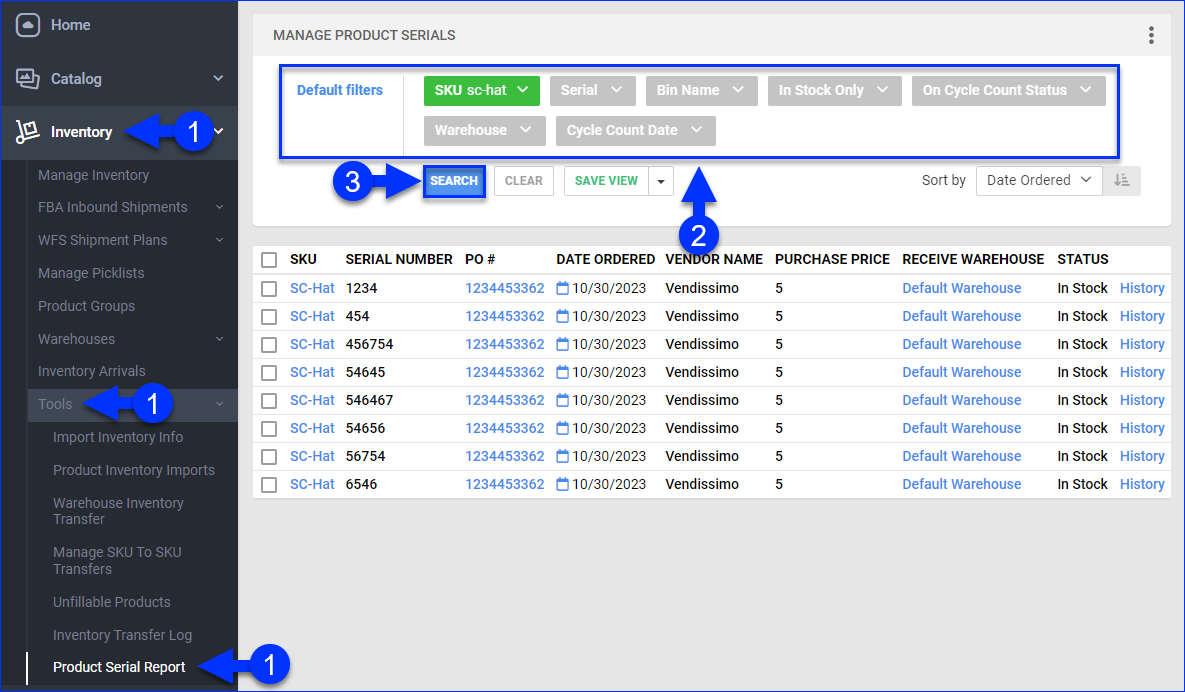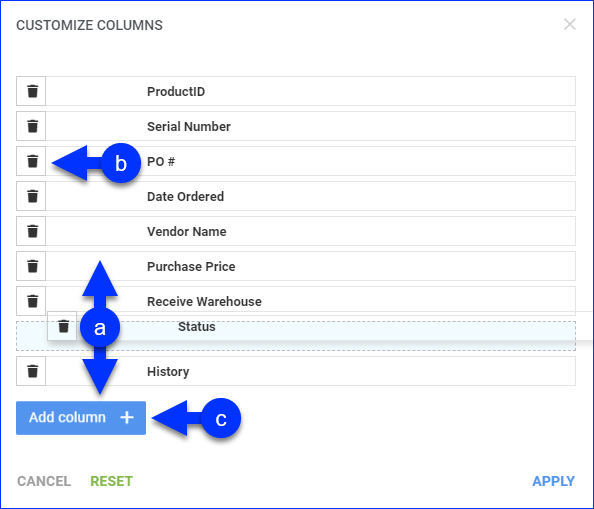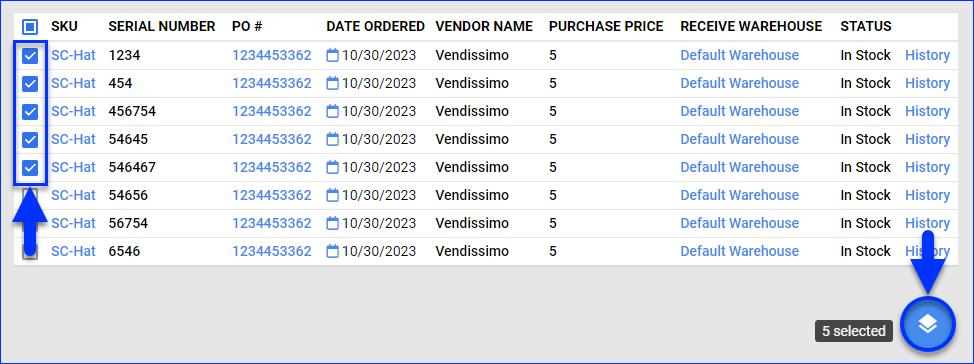Overview
In this article, you will learn about Sellercloud’s Product Serials Report. This report allows you to track the history of product activity (POs, orders, and FBA inbound shipments) associated with specific Serial Numbers. The report consists of data columns that display the following information:
- Product Details: SKU, Serial Number, History, Status, and Last Cycle Count Date.
- PO Details: PO Number, Date Ordered, Vendor Name, Purchase Price, *PO Receive ID, *Vendor ID, Receiving Warehouse, *Receiving Warehouse ID, Bin Name, and Credit Memo Number.
- Order Details: Order Number, Order Date, and *Unit Price.
- FBA Shipment Details: FBA Shipment Number, Ship From Warehouse, and *Ship From Warehouse ID.
Product Serials Report
To access the report:
- Go to Inventory > Tools > Product Serial Report.
- Optionally, set up the Default filters. See the Filters section of this article for details.
- Click Search. Each filter you apply gets highlighted in a distinct green color. If a filter is gray or not displayed at all, it’s not active.

- Click on a PO # to be directed to the PO Details page where it was received and History to view the serial number’s history.
Customize Columns
To manage the data columns in the report:
- Click the three dots icon on the top right.
- Select Customize Columns.

- Now you can manage the report’s data columns:

- To reorder columns, drag them up or down in the list.
- To hide columns, click the Trash icons.
- To add columns, click Add column.
Sort Data
By default, the report is sorted by Date Ordered, which is the date when the associated PO was placed. To sort the report data differently:
- Click the Sort by menu on the right and select another data column.
- Click the icon next to the Sort by menu to switch the sorting order.

Save View
To save your filter, columns, and sorting setups:
- Set up the filters and customize the columns on the page.
- Click Save view.
- Type a Name and click Save.
- You can now access your saved view by selecting it on the top right.

Export
To export the report to a spreadsheet:
- Select your desired serial number/s from the grid.
- Access the Actions menu in the bottom right.

- Select Export to Excel.
Filter and Column Definitions
This section defines the filters and data columns that let you tailor the report according to your needs.
Filters
The report can be customized to show specific data with these filters:
| Thing | Description |
| SKU | Show only one or more specific SKUs. |
| Serial | Show only one or more Serial Numbers. |
| PO # | Shows only serial numbers included in the specified Purchase Order. |
| Vendor | Shows only serial numbers of SKUs purchased through the specified Vendor. |
| Bin Name | Show only serial numbers in a specific Warehouse Bin. |
| In Stock Only | Show only serial numbers that are in stock. |
| On Cycle Count Status | Show only serial numbers included in a Cycle Count report. |
| Warehouse | Show only products stored in one or more Warehouses. |
| Cycle Count Date | Show only serial numbers included in a Cycle Count report within a specified date range. |
Data Columns
The report’s web interface can display the following data columns:
| Thing | Description |
| SKU | The product’s unique Sellercloud Product ID. |
| Serial Number | The product’s Serial Number. |
| PO # | The number of the PO where the product was ordered. |
| Date Ordered | The date when the PO was ordered. |
| Vendor Name | The associated Vendor’s name. |
| Purchase Price | The SKU’s Unit Price on the PO. |
| Receive Warehouse | The warehouse where the product was received. |
| Ship Warehouse | The warehouse from which the product was shipped. |
| Bin Name | The specific location or bin within a warehouse where the product was received. |
| Status | The status of the product: In Stock, Returned To Vendor, or Shipped To Client. |
| History | The records of the serial number’s movement history over time. |
| Credit Memo # | The reference number of the associated credit memo issued for the product. |
| FBA Shipment # | The reference number of the associated FBA Inbound Shipment. |
| Last Cycle Count Date | The date of the most recent cycle count for the product. |
| Notes | Displays the custom note added to a specific Serial Number. |
| Order # | The associated order number. |
| Order Date | The date when the order was placed. |
When you export to a spreadsheet, you also get the following columns:
| Thing | Description |
| PurchaseReceiveID | The reference number of the associated PO Receiving. |
| VendorID | The reference number of the associated Vendor. |
| SaleOrderTime | The date when the associated order was placed. |
| SaleOrderPrice | The unit price of the product on the associated order. |
| SerialReceiveWarehouseID | The unique ID number associated with the receiving warehouse. |
| ShipFromWarehouseID | The unique ID number associated with the Ship From warehouse. |